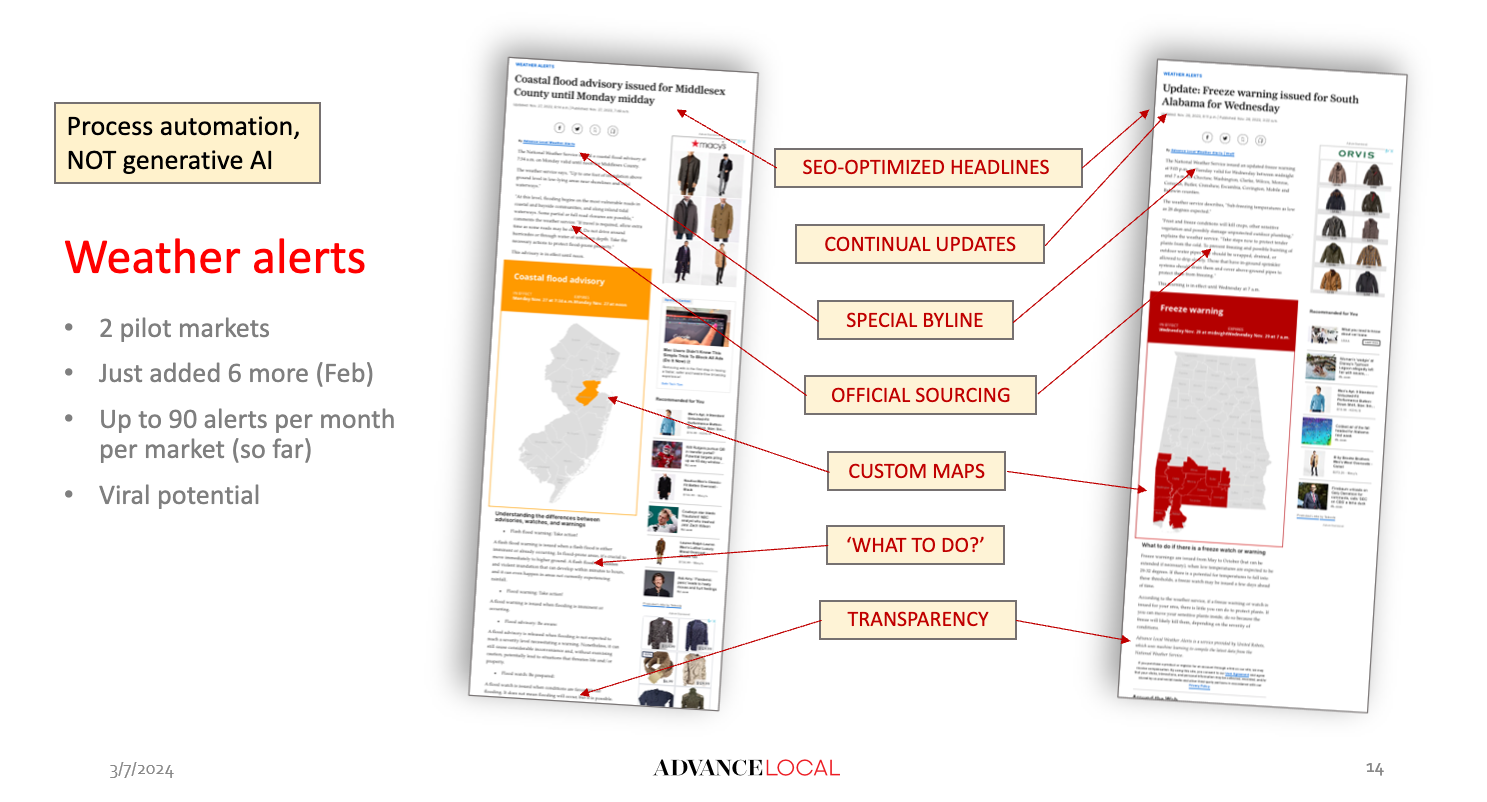Weather warnings – triple win for local US newsrooms

Problem solved: Because automated editorial content is created from verified, structured data, it can safely be automatically published – from reliable data comes reliable text. This reliability lies behind a number of values gained in the newsrooms of Advance Local who publish automated weather warnings. Advance Local VP Content Strategy Lamar Graham and Matt Dowling, Director of Breaking and Local News at NJ Advance Media explain how the newsrooms work with, and benefit from, the automated content.
“This is stuff that adds value, it helps support the website, it helps support the mission and it frees up the time for our reporters to do the more meaningful work. And that has made a big difference for us.”
Matt Dowling, Director of Breaking and Local News, NJ Advance Media
Advance Local’s venture into the use of automated content began in 2022, and had nothing to do with extreme weather. The media group has ten local markets, one of which is Massachusetts. There, the newspaper the Republican in Springfield had for a long time been publishing a listing of all the homes sold in Hampton County in print, collated manually from a spreadsheet. When they started publishing the same content online, they realised it was converting readers into subscribers, “and that’s when a light bulb went off,” says Lamar Graham. If they could replicate this type of content across many more markets, it would potentially amplify the effect. But having reporters manually put together lists to achieve a few hundred pageviews was not viable. “But what if we could somehow automate this and hoover up a bunch of this data around the country and scale it – that might be worth something. This was our hypothesis,” says Graham. Researching options, Advance Local came across United Robots and discovered we had already done the data hoovering and had automated real estate content production for the US in place (albeit from Malmö, Sweden). Advance Local started testing the automated real estate content at Masslive.com in 2022, and rolled it out to all other markets bar one in 2023.
 The automated weather warning content packages include state maps, with the affected county/counties highlighted in colour.
The automated weather warning content packages include state maps, with the affected county/counties highlighted in colour.
During the summer of 2023 United Robots developed a new content service for the US; automated weather warnings, based on data from the National Weather Service. The NWS data covers over 100 distinct weather events, and the robot scans the data every five minutes, so the automated alerts are always up-to-date. Lamar Graham asked the local editors whether they were interested, and in October New Jersey and Alabama became the test grounds. By January, the content was pushed out automatically and in mid-February six further markets went live with the extreme weather updates. So how are the automated weather warnings helping Advance Local’s newsrooms? The content is very new, but based on the experiences at NJ.com, there are at least three distinct wins:
Speed. The weather data is checked every 5 minutes, and texts generated literally instantaneously. “We actually see the Slack alerts from United Robots about a new text having been published pop up faster than the updates from NWS in Twitter,” says Matt Dowling. “And the content is already done – which means the reporter dedicated to weather can immediately link to that. So we get the base of a story first, and then work off of that and cut down on the time to letting people know something's going on.”
All weather alerts are auto-published to the weather section at NJ.com. There are four different classes of weather alerts, and at the moment work is going on to be able to automatically publish anything classed as severe or extreme to the homepage as well (this is currently done manually).
24/7 coverage. A key advantage of the automated weather updates specifically, is that they constitute around the clock coverage of critical community events, whether or not there are reporters in the newsroom. Matt Dowling explains the significance: “We're unstaffed six hours on weekdays and about seven hours on weekends, and on weekends we don't always have a weather expert working. So this really helps complement the times of days where we don't have the people with the expertise to handle the larger stories on weather reporting in particular. In New Jersey specifically we get these snow squalls from time to time ripping across the state. They are not frequent events, but they are very dangerous if you’re driving – in these instances we have a 15 minute window to let people know that there's a public safety issue in front of them, and five minutes really matter.”
Pageviews. Content views is the main KPI for the content automation project at Advance Local. While automated real estate articles are fairly predictable in terms of volumes per month, weather warnings, of course, are not. On the other hand, if there are dramatic events, this content can drive a lot of views. During the two last weeks of February, when eight of Advance Local’s markets had all gone live with automated weather warnings, they published 580 weather alerts (1100 if you include updates on existing events). The content generated about half a million pageviews in the two weeks.
It will take a full year of weather events before Advance Local will be able to fully evaluate the effect of the automated weather warnings. But Matt Dowling is clear that the automated content in general is having a positive impact in the newsroom. “This is stuff that adds value, it helps support the website, it helps support the mission and it frees up the time for our reporters to do the more meaningful work. And that has made a big difference for us.”
